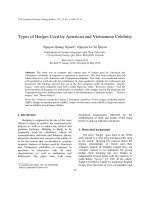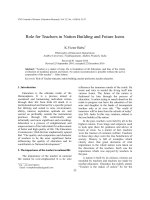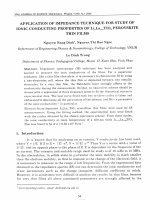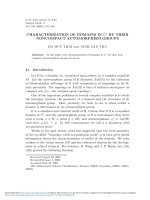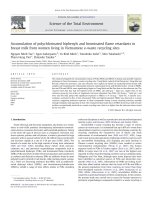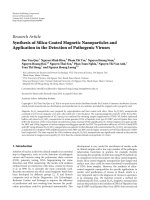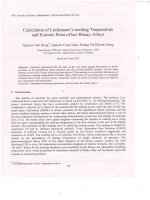DSpace at VNU: Application of 5S in Vietnamese Small and Medium Manufacturing Enterprise-Current Situation and Soluions
Bạn đang xem bản rút gọn của tài liệu. Xem và tải ngay bản đầy đủ của tài liệu tại đây (7.85 MB, 16 trang )
APPLICATION OF 5S IN VIETNAMESE SMALL AND
MEDIUM MANUFACTURING ENTERPRISES - CURRENT
SITUATION AND SOLUTIONS
Nguyen Dang Mitth - Do Till Cue Ta Thi Huong Giang - Hoang Till Thu Ha
I. INTRODUCTION
The economy is changing more competitively, modern corporations nowadays
growth through improving efficiency o f manufacturing as well as delivering higher
quality goods and services to attain higher customer satisfaction. In Vietnam, on the
path to build up a market - oriented socialist economics, the contribution of
corporations, especially Small and Medium Enterprises (SMEs) are playing key
roles. More than 280,000 SMEs accounting for about 98 percent o f total number of
firms around Vietnam in 2011, this segment contributes about 30 percent o f GDP
annually. These enterprises not only employ for millions labor each years but also
donate the national wealth so that supporting SMEs development always is top
priority among government policies. However, small scale and lack o f capital as
well as human problems are the reasons that make many SMEs still are in
struggling to survive. To solve this problem, entrepreneurs take chances o f
globalization and integration to learn oversea successful key for business. Certainly,
the exactly imitation is not allowed due to difference in culture and business
circumstance as well as level o f manager. Thus, learning from oversea knowledge
and implementing for Vietnamese case are still at first stage and always need
support from both government and society.
Come from Japan, a traditional Asian country and home o f powerful
corporations, 5S is a tool that applied successful and commonly for a long times. It
is methods o f maintaining good housekeeping so that firms can enhance the
production efficiency as well as quality o f goods and services. This method was
applied firstly by Osada in 1980s, Then, many firms throughout Japan also start to
implement 5S to reduce waste and improve productivity (Osada, 1991). 5S is
* University o f Economic and Business, VNU
498
APPLICATION OF 5S IN VIETNAMESE...
abbreviation o f five Japanese words which starting with S: Seiri, Seiton, Seiso,
Seiketsu, and Shitsuke (Ho, 1997). Nowadays, 5S also is implemented in many
countries and five Japanese words with s starting also is adapted in local language.
Particularly, in English, they are Sorting, Straightening, Shining, S t a n d a r d i z i n g and
Sustaining (Lonnie Wilson, 2010). 5s is good way to maintaining housekeeping and
environment performance as well as safety and systematic workplace (O’Eocha,
2000). Most organizations started practicing 5S in manufacturing areas before
applied it in office based environment (Stephen J. and Graeme, 2004). Through
time, 5S is developed and integrated with other method for better improvement and
higher efficiency with other method such as Kaizen ideas (Imai, 1997 and Kodama,
1959) and visual control (Nikkan Kyogyo Shinbun, 1995). Also, 5S is used as
foundation o f other managing activities such as Total Quality Management (TQM)
(Ho et. al, 1995) and Total Productivity Management (TPM) (Ho and Fung, 1995).
In lean manufacturing system, 5S is applied as a basic tool to maintain
housekeeping (Becker, 2001) and implement lean (Hines et.al, 2004). In Vietnam,
the concept of 5S have been developing and applying in firms under the guidance o f
Vietnam Productivity Centre (VPC). It is an effective and suitable method for
Vietnamese firms in starting to enhance productivity and improve product quality
(Phan Chi Anh, 2008).
However, the number o f Vietnamese documentary about 5S implementing and
how to integrating effectively 5S with others methods is still limited. Besides, how
well it works and what is the current situation o f implementing 5S in Vietnamese
SMEs are still questioned so that restrict supporting and developing it in Vietnam.
Aimed to provide a picture about the fact o f 5S applying in SMEs for superior
support, this paper would like to provide closer look at firstly the overview about 5S
theoretically and provide reality about how SMEs are exploit this useful method
through survey from Northern manufacturing SMEs. Furthermore, final part of this
paper would analyze difficulties that they are facing and suggest practical
countermeasure that firms should apply to implement 5S more effective.
II. M ETH O D O LO G Y
There are three phases in process o f conducting this research. The first stage is
collecting data. This information source was create by combination o f secondary
data and primary data which built from survey fifty-two Northern Manufacturing
SMEs as well as semi-constructed interview for deeper analyze. The second stage is
figuring out problems that hide inside the whole picture drawn from previous
phrase: How SMEs are exploiting result of 5S? What factors cause this problems?.
Based on the problem in current situation and using 5whys method, research point
499
VIỆT NAM HỌC - KỶ YÉU HỘI THẢO QUỎC TẺ LẰN THÚ TƯ
out the roots o f the problem: lean did not develop in Vietnamese SMEs. After that,
some suggestions are given in third stage in order to enhance effectiveness o f 5S
implementation in these enterprises.
Figure 1: M ethodology
500
A P P L I C A T I O N O F 5 S IN V I E T N A M E S E .
III. O VERVIEW OF 5S
5S is a method in total quality management system that originated from Japan
during the period time from 1960s to 1970s. This is difficult period in history of
Japan economics after World War II. Japanese firms startina apply 5S with the idea
about good housekeeping is the basic o f maintaining and improving productivity
and quality.
Five components o f 5S are abbreviation o f five Japanese words which starting
with S: Seiri, Seiton, Seiso, Seiketsu, and Shitsuke. In different countries, 5S could
be translated into dialects for better adaptation but still keep the same meaning. For
example, in English. 5S contain Sorting, Straightening, Shining, Standardizing and
Sustaining and in Vietnamese, these five s represent Sàng lọc, sắp xếp, Sạch sẽ,
Săn sóc và Săn sàng.
1. 1. Seiri (Sorting)
Seiri is the way tools, equipment, materials, documents is organized follow logical order so
that the workplace is keeping clean, tiny. All the items could be sort in prioritizing per
requirement and keeping them in easily-accessible place. One common approach Seiri is
using “red card" to tai’ any unnecessary items. These tagged items would be consider
whether i t ' s in right p l a c e o r n o t a n d p e o p l e w h o r e s p o n s i b l e f o r t h i s a r e a w o u l d m a k e
decision to keep this items or not. Sorting process will classify everything in workplace so
that eliminate time o f m oving and searching for tools or document and also create a safer
work environment.
2. Seiton (Straightening)
In J a p a n e s e , S e ito n m eans is a r ra n g e d e v e r y th in g n e a t a n d o rd e rly . So, w h e n in tro d u c e d into
Vietnam, S2 is called Straighten. After removal o f unnecessary items, the next task is to
organize them effectively so that they can be easy to find, and easy to repay after using.
Typically this process starts by looking at the usefulness and frequency o f using these items
to decide its location. In this step, the items need to be identified by labeling or numbering to
easily locate the best location, on the principle o f visual management: "a place for each item,
each item has a unique position." Through Seiton activities, the working environment would
become more convenient and tidy that inspire employee for better work result.
3. Seiso (Shining)
Seiso - the third s means that shining and keeping the workplace clean. Main task in this
section is kept clean throughout the organization of the overall hygiene and daily cleaning
machinery, supplies, and work areas. Seiso aims to improve the working condition, reduce
risk, accidents, and improve the accuracy o f machinery and equipment (due to dust).
Hygiene regularly also can test machines, devices which detect problems such as dust in
m achinery, the
place
loose
screws,
broken
screws
so that w e
quickly
f in d s o l u t i o n s to
problems, improve the productivity o f machinery, equipment and safety at work.
Ap pl yi ng these first t hree s, firm can achieve a m a z i n g results, thus, contributing for
improving productivity and profitability for the business.
501
VIỆT NAM HỌC - KỶ YÉU HỘI THẢO QUỎC TÉ LẲN T H Ử TƯ
Figure 2: 5S principles
In summary, 5S practices to help businesses build environment clean, tidy and safe
at work, promoted creativity in employees and develop discipline and corporate culture.
For business enterprises, the benefits can be identified through model PQCDSM:
- Improve productivity (P - Productivity).
- Improved product quality (Q - Quality).
4. Seiketsu (Standardizing)
ỉn Vietnamese, Seiketsu also is translated as “săn sóc”, which mean focusing on the purpose
of maintain standard and operating resuits in the first three Ss. Its goal is long-term
maintenance 3Ss activities rather than a temporary movement. Therefore, ensuring the
accuracy is essentia! to maintain the achievements of the previous operation. In addition,
organizations and businesses may make regulations, rules, plans, etc. to be able to control
the development and implementation of 5S. Other important in Seiketsu contents are
operational test and evaluation 5S performance. By developing S4, 3S activities will be
gradually improved based on the standards set out and proceed to complete the 5S business.
5. Shitsuke (Sustaining)
Shitsuke is the final activity of 5S. This “S” meant to be trained to make up a daily routines
and habits of employees in implementing 5S. Ready can be interpreted as training people to
follow standard and strict monitoring rules in the workplace. However, when the
improvement opportunities appear, ready will help firm make changes as appropriate easily
Thus, the in S5 content, the training of 5S is the most important point, help the 5S activities
are maintained and developed to the highest level, thus contributing to improve productivity
and product quality.
502
APPLICATION OF 5S IN VIETNAMESE.
- Cutting costs (C - Cost).
- Delivery (D - Delivery).
- Ensure safety at work (S - Safety).
- Raise awareness and discipline for employees (M - morale)
As a simple method, ju st changing in mind thinking o f manager and employee
and also a methodology that sharing the same perspective “Cleanliness is next to
eoodliness” of Vietnamese, 5S is less costly way for firm to a bring up hieher
performance with cleaning and efficient working environment.
IV.
C URRENT SITUATION OF 5S PRACTICE IN VIETNAMESE
MANUFACTURING SM A L L AND MEDIUM ENTERPRISES
1. Small and medium enterprises in Vietnam
The above part represent literature reviews and some theories about 5S, this prove
that 5S is 2;ood method to improve company performance. We analyze continuously
the current situation application 5S in Viet Nam through survey at 52 SMEs.
According to the Vietnam government regulations, small and medium
businesses is a registered business under the law with total capital under 100 billion
VND or number o f employees less than 300. In recent years, the number o f SMEs
increased continuously and accounts for approximately 97% o f businesses operating
across the country. C ontributing more than 30% in G D P and creating thousands o f
jobs for the society, the development o f SMEs are considered as an important
strategy in Vietnam ’s development.
Due to small scale in both capital and number o f employees, SMEs often are
highly flexible, adaptable to changes in business environment. However, because of
low technological capabilities as well as the limited capital, a great number of
SMEs in Vietnam are falling, stagnating and facing bankruptcy during the
downturn. Therefore, Vietnam government has been supporting for enterprises to
access capital and technology as well as efficient management and production
methods. And, 5S - a Japanese method, that is very simple but efficiency of
production to improve company environment and performance is one way to
develop SMEs. We conducted survey in 52 SMEs in Viet Nam, and went to reality
to research and investigate the current situation o f application 5S in Viet Nam.
2. Current situation o f lean practices in Vietnamese small and medium
enterprises
Following the Japanese firms, 5S was introduced in Vietnam in the early 21s
century. After 10 years o f development in Vietnam, 5S has brought many benefits
503
VIỆT NAM HỌC - KỶ YẺU HỘI THẢO QUÒC TẺ LÀN THỬ TU
to enterprises, especially SMEs during the economic downturn. In 2002, a
workshop on methods and experience o f Japan in productivity management held by
Vietnam Productivity Center and Asian Productivity Organization introduced
overall TQM tools to Vietnamese enterprises. In the following years, a series o f
programs to support for applying lean in Vietnam was organized and obtained good
results. In June 2010, program " Enhancing capacity to support industry in
Vietnam" held by JICA and SME TAC help Vietnamese SMEs to apply a number
o f tools o f lean such as 5S, kaizen, visual management, TPM, ...However, up to
now, these methods has not been widely applied in Vietnamese enterprises.
However, the number o f enterprises that has been supported in this program
achieved about 170 enterprises, account for a very small proportion (less than 1%)
o f SMEs in Vietnam. In 52 companies, we conduct the survey to exam how 5S
apply in Vietnamese SMEs, and which level application o f 5S in SMEs is. We exam
the relationship between 5S and productivity efficiency, workplace and
performance before and after a p p ly this tools. The r e s u lt - the table o f this survey
show that the application o f 5S in SMEs is medium, follow JICA - one o f organize
in Japan to develop productivity , that cooperate with SME - TAC, and through the
survey and real observation, the level o f apply 5S stood at level 3 in 5 level. It
means that, the SMEs, which are applying 5S, only achieved 3S (Sort, Straighten,
Shine). Most o f these companies is trained or guided by volunteer in Japan, but they
still have not yet apply 5S completely and successfully.
Table 1: Results o f survey at 52 companies about 5S practice
5S
M in
M ax
M ean
STD
1
Training 5S awareness for employees
1.00
5.00
4.28
0.93
2
Formulating 5S committee
1.00
5.00
4.24
0.80
3
Developing and Establishing 5S standard
1.00
5.00
4.10
0.74
4
Maintaining daily 5S at office and showroom
1.00
5.00
4.00
0.94
5
Maintaining daily 5S at shop-floor
1.00
5.00
3.75
1.05
x6
Maintaining daily 5S at warehouse
1.00
5.00
3.98
0.99
7
Promoting 5S to suppliers network
1.00
5.00
3.54
1.12
Actually, 52 companies in survey were typical in applying 5S method. And
most of company located in Hanoi or Ho Chi Minh City. In a bis city, where
information network is very developing and receive more support from government,
those SMEs still cannot apply fulfill 5S method, so in the rural areas may be the
number o f application o f 5S is much small. It is reason why we can estimated that
504
APPLICATION OF 5S IN VIETNAMESE.
there are only small num ber o f SME apply 5S in Viet Nam. M oreover, the number
of SMEs that has successfully applied is smaller.
Besides survey at 52 M SM Es, deep interview was carried out at 3 enterprises
in Hanoi: Hanel JST Company, CN C-V IN A and Shorai Limited Company.
2.1. H anel Plastics Joint Stock Company
As one o f the first joint stock companies in Hanoi, Hanel Plastics JSC was
founded in 1994. Its main products are plastic and foam products for other
industries.
With the support from the program “Enhancing capacity to support industry in
Vietnam”, Hanel has applied the 5S, kaizen into the plant since 2009. In the first
phase, company held training program for employees with basic knowledge of 5S,
kaizen, TPM,... After training, cleaning campaign was done in the entire of
company, machines, facilities and products were filtered and rearranged logically
and scientifically. During implementation process, the enterprise also made
improvements to reduce lead-time for arriving and operating. As a result, the
effectiveness o f the t o o l s 5S, kaizen is evidence in the work environment as well as
business result.
Table 2: Business performance o f H anel in 2010 and 2011
2010
(VND)
2011/2010
355,799,459,721
244,417,127,586
146%
Net revenue from operating
12,274,437,332
8,492,201,326
145%
Net profit
9,802,473,216
6,963,307,919
141%
Criteria
2011
(VND)
Net Revenue
Source: Hanel financial statement, 2011.
2.2.
Vietnam CNC and Technology application Joint Stock Company (CNC-
VINA)
C N C-V IN A was established in 2007 and engaged in the field o f machine
manufacturing and automatic control. With the support o f program “Enhancing
capacity to support industry in Vietnam", the com pany has applied CNC-VINA
tools 5S, kaizen since its establishment. W hen first applied, the training programs o f
these tools are held regularly to the board o f directors and managers. Then, the
training for staffs was implemented. At the same time, com pany also organized and
505
VIỆT NAM HỌC - KỶ YÉU HỘI THẢO QUỎC TÉ LẰN TH Ứ TU
arrar.ged machinery, equipment, products to eliminate lead-time. Continuous
improvement, kaizen was encouraged in the enterprise, so work environment and
productivity o f CNC were improved significantly.
2.3. Shorai Vietnam Company Limited
Shorai Vietnam Co., Ltd, a member o f A Long Corporation operates in support
industries. Its director is Japanese, so Shorai applied 5S and Kaizen when it was
established in 2011. With support o f program “Enhancing capacity to support
industry in Vietnam”, Shorai hold a number of training programs for its managers and
employees. After that, it began practicing 5S and kaizen under supervision of
director. Application process at the company almost a year but only gives efficient
large companies. The company has made continuous improvements to reduce leadtime as well as manipulate time in the production process. Up to now, Shorai received
a lot of orders from the ereat enterprises such as Toyota, Dongfeng, Truong Hai,
Thong Nhat...
There cases imply the change in performance and efficiency after applying 5S
in specific case and in specific number. So, 5S can apply in Viet Nam and bring
many good result for SMEs. Besides good news, there are some true stories that we
need to know that even the companies is considered quite success in application 5S,
the level o f application still stood at level 3. It may suggest that, may be many other
companies apply 5S is stood at lower than level 3. Even though, many SMEs have
never access concept o f 5S. It will lead to the number o f SMEs apply 5S is small.
The less, with typical success stories in Vietnam, the authors have drawn three
major lessons that the company has successfully applied to implement lean; good
leadership, management capability and suitable training program. Those cases show
that 5S (and some other methods) is a very useful method that helps enterprises
increase profit and it can be adopted in Vietnamese SMEs. However, those are only
the initial successes; it would take more time to popularize lean in Vietnam. To find
out the reason why 5S still have yet develop in Vietnam, and reasons for there are a
little o f company apply 5S in SMEs, we can consider the next part.
V.
THE
CAUSES
d evelopm ent o f lean
OF
PR O B LE M
AND
SOLUTIONS
FOR
p r o d u c t i o n i n V IETN A M ESE E N TE R PR ISES
1.
T he causes th a t lead to u n d erd ev elo p m en t of 5S in V ietnam ese Sm all
an d M ed iu m E n te rp ris e
Although 5S is an effective method that helps Vietnamese SMEs eliminate
wastes and improve productivity, 5S has not yet been applied widely in Vietnam. In
order to point out the roots of the above issue, tree diagram o f causes was built
based on 5Whys method and the survey results. The tree diagram consists o f 6
50 6
APPLICATION OF 5S IN VIETNAMESE.
layouts where present the causes lead to the results in the previous layout. Therỉ are
9 causes that lead to the problem: 5S are not applied widely in Vietnamese SMEs:
- Lack o f enterprise leader’s commitment in 5S practice
- Ineffective propaganda about 5S in Vietnam
- Limited capability of leaders
- Lack o f 5S specialists
- Poor quality training 5S program
- Lack o f Vietnamese materials about 5S
- Lack o f supervision in 5S practice
- Lack o f support from government in accessing capital
- Lack o f initiative in learning from other enterprises
Based on the result o f survey at 52 companies, there exist 7 the most critical
reasons that make 5S practice unpopular in Vietnam.
L I. Lack o f enterprise leader’s commitment in 5S practice
In enterprises, leaders or Board o f Directors (BOD) play a vital role in
orienting the development strategics as well as 5S practice plan. BOD will set up
the goals and necessary resources in plan o f applying 5S, so that commitment OÍ
B O D in 5S practice is essential for enterprise to implement 5S plan successfully. In
addition, strong commitment o f leaders could make employees aware o f importance
o f 5S in company, since then encourage them to do 5S activities effectively. In
short, leader’s commitment is a key for success o f 5S plan in MSMEs.
1.2. Ineffective propaganda about 5S in Vietnam
Although 5S was imported in Vietnam for over 10 years, it is still considered
as a new method in many Vietnamese MSMEs. It is a really useful method that
helps enterprises improve productivity, but there is no propaganda campaign about
5S in Vietnam Therefore, at the present, there are few SMEs that knew and applied
this method in management and production.
1.3. Lack o f 5S specialists
5S is still new for many Vietnamese SMEs, so that it is difficult for those to
apply 5S in company properly. Specialists who have deep understandings about both
5S and Vietnamese business context will support SMEs to develop strategy and to
overcome the difficulties in implementation plan, especially in the beginning stage.
Without support from specialists, enterprises could face to the failure o f 5S plan, so
lack o f 5S specialist is a critical reason that leads to problem in applying 5S.
507
VIỆT NAM HỌC - KỶ YỂU HỘI THẢO QUỎC TÉ LẰN TH Ử TƯ
Figure 5: The tree diagram of causes
r
Fluctuation in
m arket that
lead to
changes in
strategies for
applying 5S
Lack o f
favorable
outside
factors
f
Lack o f long
term
strategies for
5S practice
__
J
V
N
( 1)
Lack o f
enterprise
leader’s
com m itm ent to
5S practice
^
The tree analysis
with 6 layouts
analyzes reasons
y
why 5S has not yet
been applied
f
Lack o f
supports for
applying 5S
from
governm ent
Lack o f
awareness
about benefits
o f 5S practice
N
( 2)
Ineffective
propaganda
about 5S in
Vietnam
__
Vietnamese
SMEs by using
J
V
5whys method.
s ................
' V
Poor
(
m anagement
system
5S
practice
are not
applied
w idely in
Vietnames
e MSM Es
widely in
r
Limited
capability o f
leaders
---
/
The main
causes
\
J
V
(3)
Lack o f 5S
specialists
Lack o f
resources to
apply 5S in
com pany
Poor quality training 5S
program
Poor human
resources in
5S
Poor em ployee’s
know ledge about
5S
f
Lack o f V ietnam ese
m aterials about 5S
(4)
(5)
)
Poor
consciousness o f
em ployees in 5S
Lack o f supervision in
5S practice
(6 )
Lack o f
favorable
inside
factors
Lack o f capital
and technology
investm ent to
apply 5S
v_
508
Lim ited capital
source
Lack o f support from
governm ent
(7)
APPLICATION OF 5S IN VIETNAMESE.
1.4. Poor quality training 5S program
To approach new method like 5S, training is the basic requirement in
implementation process. Training program will provide the basic knowledge about
5S as well as steps o f implementation. If training program does not meet the needs
and requirements o f enterprises, employees can understand incorrectly the 5S
philosophy. As a result, 5S could not develop in Vietnamese SMEs.
1.5. Lack o f Vietnamese materials about 5S
In Vietnam, materials about 5S are mainly in English or Japanese, so it is
difficult for SMEs to study about this method. Moreover, materials for training play
an important role in development strategy o f lean, consequently Vietnamese
documents are necessary for SMEs to practice lean successful.
1.6. Lack o f supervision in 5S practice
Vietnamese employees are not good at self-consciousness and self-discipline, so
when there is any change in work, they often ignore the requirements. If enterprises do
not supervise strictly 5S implementation process of employees, they will not have right
awareness and attitude about this method. Thus, supervising the 5S tasks in the
beginning stage is very necessary to create 5S habits for employees in work in the future.
1.7. Lack o f support from government
At the current time, Vietnam government has provided a num ber o f programs
and policies that support for SMEs to overcome the downturn period. However, the
number o f enterprises that can access to those policies is very small. Without
support from government, SMEs would face the difficulties in accessing capital
source,
technology
as
well
as
the
advanced
methods
like
5S,
Kaizen,
TPM ...Briefly, support from government is an important factor that help MSMEs
approach to capital, technology and 5S method.
2. Suggestions for 5S development in Vietnam
Based on the causes o f the issue in the previous part and results o f deep
interview in 3 enterprises, authors suggest some countermeasures to popularize 5S
in Vietnamese M SM Es. The suggestions are recommended to government and
enterprises as well as the training organizations to create the most favorable
conditions for 5S practice in Vietnam.
2.1. Suggestions fo r government
- D evelop the wide-range propaganda about 5S in Vietnam, especially in
SMEs
509
MỆT NAM HỌC - KỶ YẺU HỘI THẢO QUÓC TẺ LẰN TH Ử T ư
In Vietnam, 5S method is new for many enterprises while it has been imported
in Vietnam for over 10 years. This method can help M SM Es enhance their
P'oductivity and competitiveness, so propaganda about 5S will popularize this
rcethod to enterprises in response get benefits from this method. Government can
raise the popularity o f 5s by holding the awards or competitions about developing
the advanced methods in manufacturing and management like good 5S practice in
Metnam as annual, since then these methods can be spread around country.
- Provide the support policies fo r SM Es to 5S practice in production
At present, Vietnamese MSMEs have numerous o f difficulties in capital and
technology. Even though Government provides a number o f policies to support
SMEs in accessing the capital source and technology, the number of SMEs that can
take advantage o f those policies is very small. Therefore, government should
srengthen these policies that help enterprises set up the foundation for 5S
development.
For companies that are at the beginning stage o f implementation plan, the
State should push 5S practice in these companies through reducing tax (5-10%).
Besides, Government should form a separate fund or department that is responsible
for supporting M SM Es in Vietnam. Thereby, this department can make the
priorities policies encouraging this method. Besides, State also can encourage firms
through awarding, honoring companies that have excellent innovation or new
achievement in production such as implementing Lean successfully. Thus, 5S could
be quicker spreads among Vietnam SMEs.
2.2. Suggestions fo r enterprises
- Providing training courses about 5S
The training
programs
should
be
developed
in accordance
with
the
qualifications o f employees. It can be divided into many different courses including
reality case studies in industrial practice so that learners can easy to understand. The
effectiveness o f training also determines the success o f applying 5S. Besides,
training program should be improved continuously to get the highest impact on 5S
implementation.
-Raising awareness o f the learners about training program s.
In the first phase, companies should focus on the inspection and supervision to
ensure quality training. In addition, they also can organize internal contest about 5s.
issues and countermeasures in implementing progress, to attract attention of
employees and improve result o f courses.
510
APPLICATION OF 5S IN VIETNAMESE .
- Setting up 5S committee to monitor implementation process and persor.ml
inspecting.
In the early stage o f development, firms should construct an oversight
committee to raise awareness o f staffs and make 5S become a habit o f thinking in
work. Hence, the 5S philosophy will gradually become ingrained businesses
cultural and raise competitive position o f enterprises.
- D eveloping long-term strategies fo r 5S im plem enting integrate with compary
tactics
Successful 5S implementing in Vietnam required times, resources and plai.
Thus, firms should make a long term strategy with a fulfill preparation in human,
capital and facilities so that the applying process is not interrupted.
- Cooperating with 5S specialists and institutions to enrich Vietnamese :S
materials
Enterprises should cooperate with 5S specialists in consultant centers ard
universities to create documentary system in Vietnamese that provide fulfill theory
and guiding tools for 5S implementing that are suitable with domestic business and
manufacturing context.
2.3. Suggestions fo r training organizations
Incorporating 5S in educational institutions as a reference subject.
The basic training at schools will provide the theoretical basis for learners,
who will directly involve in business and manufacturing process in the future (work
as managers, workers, supervisors, and so on). Therefore, 5S should be added in the
training program in universities and colleges as a reference subject. These courses
will help them to have overview o f tools, benefits, and implementing paths o f 5S
and form labor force in 5S for future.
VI. CONCLUSIO N
5S is an effective method that helps firms eliminate waste and improve
productivity as well as product quality. 5S has introduced to Vietnam enterprises lor
a long time and some SMEs have recognized its benefits. However, the number of
Vietnam SMEs that apply 5S is still small (less than 1% o f total number o f SMEs).
Thus, 5S has not been widely developed in Vietnam despite the support from many
organizations such as the Small and Medium Enterprises Technical Assistance
Centre in Hanoi (SME-TAC Hanoi), Asia Productivity Organization (APO).
Vietnam Productivity Center (VPC) and Japan International Cooperation Agency
(J1CA).
511
VIỆT NAM HỌC - KỶ YÉU HỘĨ THẢO QUỎC TÉ LẰN TH Ử T ư
The research was conducted based on survey at 52 enterprises and interview at
three SMEs in Hanoi, SME SME-TAC Hanoi and JICA to provide overview of the
current situation o f 5S implementing o f Vietnam SMEs. Then, authors use causeeffect method to analysis problems and find out its main causes and propose some
practical solutions that aim to help SMEs in implementing 5S in production
systems. Due to the importance o f SMEs in national economy development, 5S
applying will have vital role in pushing economic growth. Therefore, 5S should be
studied and developed in further analysis to provide a complete model for Vietnam
business context as well as expand 5S practice for other business sectors such as
services, medicine and public services.
References
1. Alberto Bayo-Moriones, Alejandro Bello-Pintado, Javier Merio-Diaz de Cerio,
2010, 5S use in manufacturing plants: contextual factors and impact on operating
performance, International journal of Quality & Reliability Management, Vol. 27, Iss. 2,
pp. 217-230.
2. Lonnie Wilson, 2010, How to implement lean manufacturing, The McGraw-Hill.
3. Vietnam government, 2009, Decree No 56/2009/NĐ-CP, issued on June 30th, 2009
(Vietnamese).
4. Phan Chi Anh, 2008, 5S Implementation - Foundation for Productivity
Improvement, Labor Publisher (in Vietnamese).
5. Rod Gapp, Ron Fisher, Kaoru Kobayashi, 2008, Implementing 5S within a
Japanese context: an integrated m anagem ent system , M a n ag e m en t D ecision, Vol. 46, ĨSS.
4, pp. 565-579.
6. Hines, p., Holwe, M. and Rich, N., 2004, Learning to evolve: a review o f
contemporary lean thinking. International Journal of Operation & Production
Management, Vol. 24, No. 9/10, pp. 994-1011.
7. Stephen J. Warwood, Greame Knowles, 2004, An investigation into Japanese 5S
practice in UK industry. The TQM Magazine, Vol. 16, Iss: 5, pp. 347 - 353.
8. Becker. J.E., 2001, Implementing 5S to promote safety and housekeeping,
Professional Safety, Vol. 46, No. 8, pp. 29-31.
9. O’Eocha, M., 2000, Use o f 5Ss for environment management at Cooke Brothers,
The TQM Magazine, Vol.12, No. 5, pp. 321-330.
10. Ho, S.K., 1997, Workplace learning: the 5S way, Journal of Workplace Learning,
Vol. 9, No. 1, pp. 45-53.
512
APPLICATION OF 5S IN VIETNAMESE.
11. Imai, ML, 1997, Gemba Kaizen: A Common Sense, Low Cost Approach to
Management, McGraw-Hill, London.
12. Ho, S.K., Cicmil, s. and Fung, C.K.. 1995, The Japanese 5Spractice and TQM
training, Training for Quality, Vol. 3, No. 4, pp. 19-24.
13. Nikkan Kogoyo Shanbun, 1995, Visual Control Management, Productivity Press,
Portland, OR.
14. Osada, T., 1991, The 5 S ’s: Five Keys to a Total Quality Environment, Asian
Productivity Organization, Tokyo.
15. Kodama, R.. 1959, Medemiru Kaizen dokuhon, Nikkan Kogyo Shinbunsha, Tokyo
513
